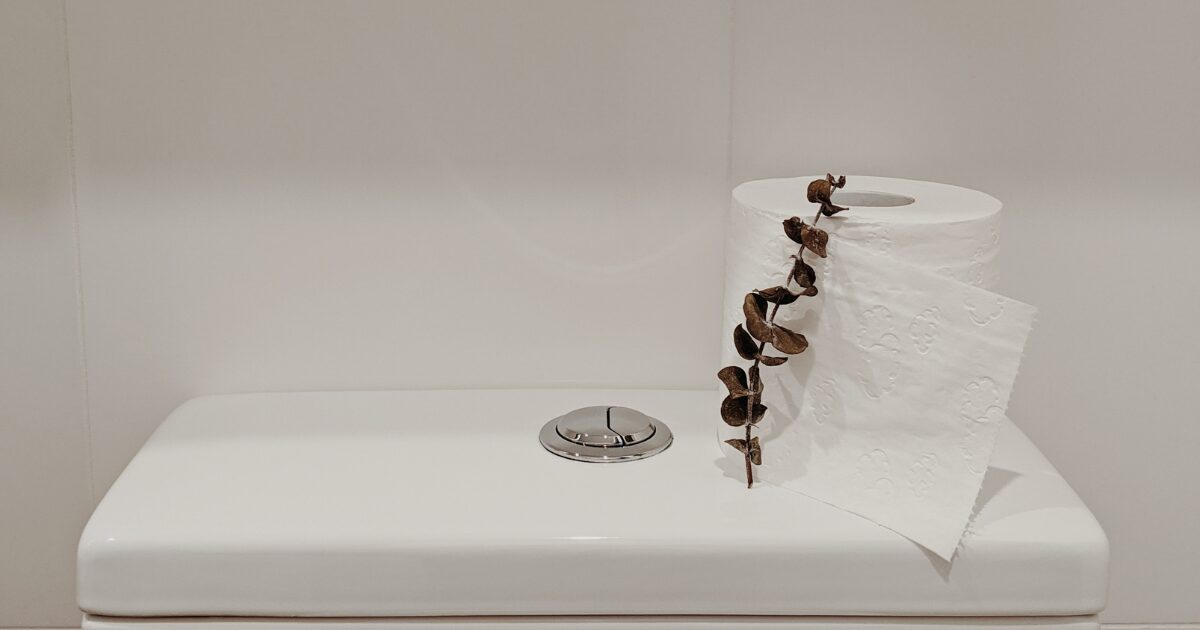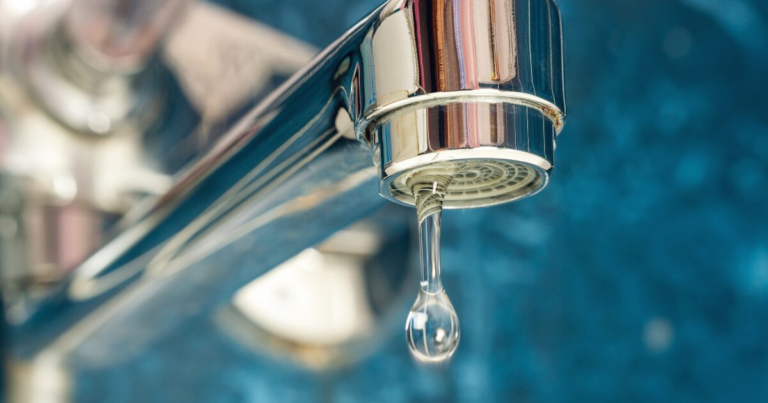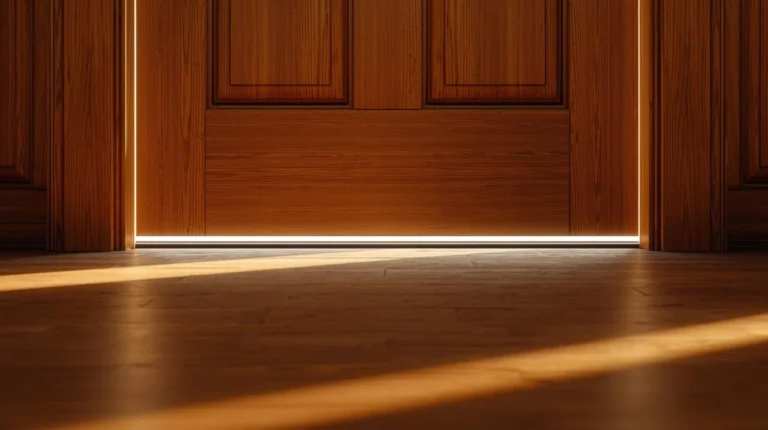A running toilet is one of the most common household annoyances. You flush, but instead of silence, water continues to trickle into the bowl—or worse, it flows endlessly. Not only is the sound frustrating, but it can also waste hundreds of gallons of water every month, adding unnecessary dollars to your water bill.
The good news? You don’t need to spend money on a plumber. With a few simple tools and inexpensive replacement parts, you can fix a running toilet without calling a plumber in less than an hour.
This guide will walk you step-by-step through diagnosing the problem, fixing the most common causes, and preventing it from happening again.
(This article contains affiliate links. If you click through and make a purchase, I may earn a small commission at no additional cost to you. I only recommend products I’ve tested, researched, or trust to solve the problem effectively.)
Why Is My Toilet Running?
There are a handful of common reasons a toilet runs continuously:
- Worn-out flapper: The rubber flapper inside the tank doesn’t seal properly.
- Misaligned chain: The chain connecting the flush lever to the flapper is tangled or too short/long.
- Float level too high: The water rises above the overflow pipe, forcing the toilet to keep running.
- Faulty fill valve: The fill valve fails to shut off water when the tank is full.
- Leaking gasket or bolts: Water seeps between the tank and bowl.
- Loose supply line connection: The water line feeding the tank leaks slowly.
👉 The majority of running toilets are caused by flapper or fill valve issues, which are both inexpensive and easy to fix.
Quick Diagnosis in Under 2 Minutes
Before you buy parts, identify the issue:
- Lift the tank lid carefully (porcelain lids are fragile).
- Observe the water: Is it running into the overflow tube, or trickling into the bowl?
- Food coloring test: Add a few drops of food coloring to the tank. Wait 15 minutes without flushing. If the bowl water changes color, you have leaked the flapper or flush valve【1】.
This quick test narrows down the problem so you don’t waste time or money.
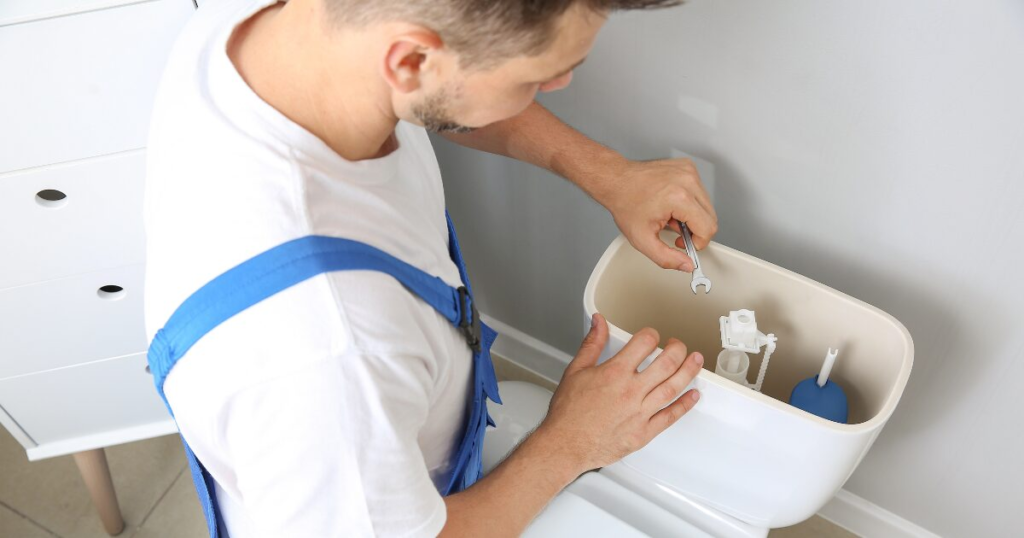
Step-by-Step DIY Fixes
1. Flapper or Chain Issues
Symptoms: Water leaks into the bowl, food coloring test confirms, the chain is tangled, or prevents a proper seal.
Fix:
- Turn off the water supply valve (usually behind the toilet).
- Flush to empty most of the tank.
- Remove the old flapper by unclipping it from the flush valve.
- Install a new universal flapper, ensuring it sits evenly.
- Adjust the chain length so it has a little slack (not too tight, not too loose).
Recommended product: Korky Premium Universal Flapper (~$12).
2. Float Level Adjustment
Symptoms: Tank fills too high, water constantly runs into the overflow pipe.
Fix:
- Identify the float type: ball float (older toilets) or cup float (modern fill valves).
- For the ball float: Bend the float arm down slightly.
- For cup float: turn the adjustment screw or clip to lower the float.
- Refill tank—water should stop about 1 inch below the overflow pipe.
3. Fill Valve Repair or Replacement
Symptoms: The Toilet runs even when the flapper is fine, or the water doesn’t stop filling.
Fix:
- Turn off the water and drain the tank.
- Unscrew the old fill valve from the bottom of the tank.
- Insert a new fill valve and tighten the nut.
- Adjust height to match tank specifications.
- Reattach the water supply line, turn the water on, and test.
Recommended product: Korky QuietFILL Toilet Valve 528FR (~$8).
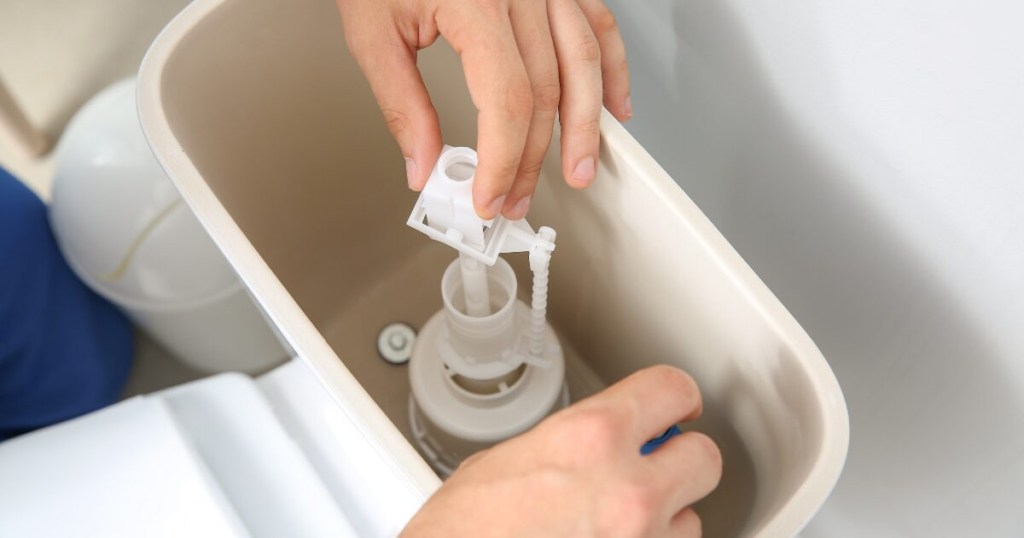
4. Tank-to-Bowl Leaks
Symptoms: Damp spots or dripping where the tank meets the bowl.
Fix:
- Drain the tank completely.
- Remove bolts holding the tank to the bowl.
- Replace the gasket and washers.
- Reassemble and test for leaks.
5. Supply Line Leaks
Symptoms: Water pooling near the toilet base, dripping from the line.
Fix:
- Tighten the supply line nut with a wrench.
- If leaking persists, replace the line (usually ~$10).
6. When to Call a Plumber
If you’ve tried flapper, float, and fill valve fixes but the toilet still runs, or you see cracks in the tank/bowl, call a professional. Complex leaks and cracked porcelain aren’t DIY-friendly【2】.
Comparison Table: Running Toilet Fixes
| Problem Area | DIY Fix | Time | Tools/Parts Needed | Cost Estimate |
| Flapper/Chain | Replace flapper | 15 min | Universal flapper | ~$6 |
| Float Level | Lower float arm/screw | 5 min | Screwdriver (maybe) | Free |
| Fill Valve | Replace valve | 30 min | New fill valve | ~$8–$12 |
| Tank-to-Bowl Leak | Replace gasket | 20 min | Gasket kit, wrench | ~$10 |
| Supply Line | Replace line | 15 min | Supply line kit | ~$10–$15 |
| Cracked Tank/Bowl | Call plumber | Varies | Pro expertise | $150–$300+ |
Prevention Tips to Avoid Future Issues
- Check toilet function monthly.
- Avoid drop-in bleach tablets—they degrade rubber seals【3】.
- Clean the flapper seat occasionally with a cloth to remove mineral buildup.
- Keep a spare flapper and fill valve in your toolbox—they’re cheap and prevent emergencies.
Expert Quotes
“A simple flapper replacement can stop a running toilet and save hundreds of gallons of water every week.” — Family Handyman【2】
“Don’t over-tighten fittings. Most DIY leaks come from people cranking bolts too hard.” — Southern Living plumbing guide【3】
Case Study: Mark’s $200 Annual Savings
Mark noticed his toilet ran all night. After replacing the flapper with a $6 universal kit and adjusting the float, his water bill dropped by $15–20 per month. Over a year, that’s $200 saved—and no plumber callout fees.
Best Amazon Products for Running Toilet Fixes
- Korky Premium Universal Flapper – chemical-resistant, universal fit (~$6).
- Korky QuietFILL Toilet Fill Valve 528FR – adjustable, quick install (~$8).
- Fluidmaster Complete Toilet Repair Kit – includes flapper, fill valve, bolts, gaskets (~$25).
- Kohler Genuine Tank Gasket Kit – for tank-to-bowl leaks (~$10–$15).
- Braided Stainless Steel Supply Line – flexible, durable (~$12).
(This post contains affiliate links. As an Amazon Associate, I earn from qualifying purchases.)
FAQs about How to Fix a Running Toilet Without Calling a Plumber:
Up to 200 gallons per day, according to EPA estimates.
Most toilets fit a universal 2-inch flapper, but some newer toilets require a 3-inch model. Always check tank size.
No—they corrode seals and void warranties【3】. Use liquid cleaners instead.
Flappers: 5–8 years. Fill valves: 7–10 years. Supply lines: 10 years.
You May Also Like,
How to Declutter Your Closet Without Getting Overwhelmed | Guide + Proven Rules
How to Lower Your Electric Bill with Simple Home Adjustments
Conclusion
Fixing a running toilet doesn’t require expensive plumbing services. With a little time and a few inexpensive parts, you can:
- Stop wasting water.
- Lower your utility bills.
- Gain confidence in simple DIY plumbing.
The next time you hear that constant trickle, you’ll know exactly what to do.
Looking for More Smart Solutions?
Find cleaning tricks, DIY fixes, and lifestyle hacks all in one place on our homepage
References
- Home Depot – How to Fix a Running Toilet
- Family Handyman – How to Stop a Running Toilet
- Southern Living – Things Plumbers Wish Homeowners Would Stop Doing
- Architectural Digest – How to Fix a Running Toilet in 6 Steps
- Roto-Rooter – When to Call a Plumber for a Running Toilet
👉 Want more interesting hacks? See our Home Hacks page.


